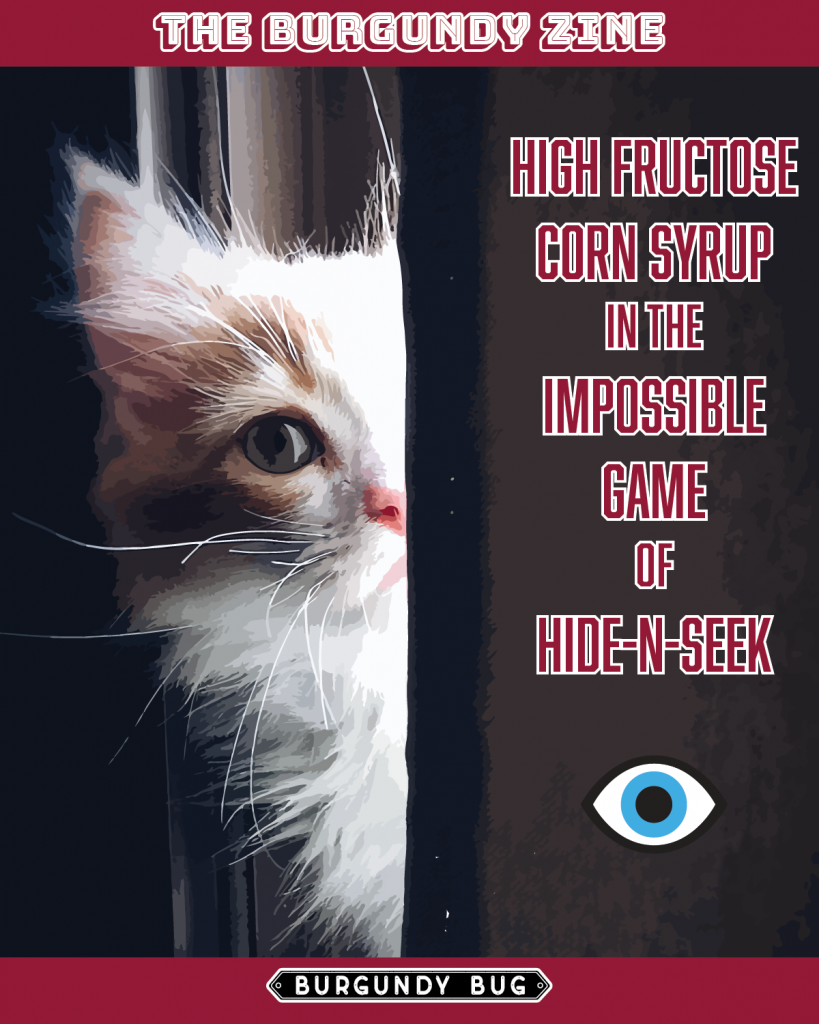March 13, 2020
High Fructose Corn Syrup in the Impossible Game of Hide-n-Seek

By: burgundy bug
High fructose corn syrup in the impossible game of hide-n-seek
Source: The Burgundy Zine
High fructose corn syrup is like glitter – it’s everywhere.
Just when you think you’ve finally eliminated it by cutting soda, candies, jams, and jellies out of your life, HFCS rears its head into your favorite soups and condiments.
So, what is HFCS? Where the hell does it come from? Why do some believe it’s “bad for you” and what should you do if you can’t digest fructose?
What is High Fructose Corn Syrup?
“High fructose corn syrup (HFCS) is actually a group of corn or potato syrups,” says a 2013 Culinary Nutrition review. “They have been processed by enzymes to increase the fructose content; then they are mixed with pure corn syrup (100 percent glucose). HFCS does not contain any artificial or synthetic ingredients or color additives, and it meets the FDA’s requirements for the term natural. HFCS is relatively inexpensive.”
HFCS, sucrose, honey, and multiple fruit juices all contain fructose, a simple sugar with the same sweetness, caloric-content, and glucose to fructose ratio as table sugar.
“HFCS helps to keep foods fresh, lowers the freezing point, retains moisture in bran cereals and breakfast bars, enhances fruit and spice flavors, promotes surface browning, and provides fermentability,” the study adds.
The ratio of fructose to glucose (and other sugars) generally ranges from 42 to 55 percent in HFCS. HFCS 55 is commonly used to create soft drinks, while HFCS 42 can be found in fruit-flavored beverages and baked goods.
How is High Fructose Corn Syrup Made?
As its name implies, HFCS is created from corn.
First, the corn is milled into corn starch and undergoes further production (heating, the addition of sodium hydroxide and/or hydrochloric acid) to become corn syrup, a 2010 Biotechnology and Molecular Biology Review explains.
Then, enzymes are added to break down the glucose in corn syrup into fructose.
High Fructose Corn Syrup vs. Corn Syrup
HFCS and corn syrup are not the same. Corn syrup, sometimes called “glucose syrup” is 100-percent glucose because enzymes haven’t been added to the production to convert glucose into fructose.
Why is High Fructose Corn Syrup “Bad For You?”
Although HFCS contains the same glucose to fructose ratio as table sugar (sucrose), according to the 2013 Culinary Nutrition review, HFCS often receives the blame for contributing to obesity and diabetes – but the correlation has yet to be proven.
“Studies that compare HFCS to sucrose conclude that they essentially have the same physiological effects, with little or no evidence that HFCS is different from sucrose in its effects on appetite or the metabolic processes that are involved in fat storage,” the study says. “An expert panel concluded that the current evidence is insufficient to implicate HFCS as a causal factor in overweight and obesity in the United States.”
Instead, the study points to the rise in fruit and soft drink consumption as the focal point for obesity and diabetes, not HFCS itself.
“Like many other sweeteners and dietary substances, HFCS should be used in moderation along with a well-balanced diet, if at all,” the study says.
However, there are cases in which HFCS can be “bad for individuals” who can’t digest fructose, leading to a whole world of troubling symptoms.
Fructose Malabsorption
Fructose malabsorption can lead to digestive disturbances, such as abdominal pain, gas, chronic diarrhea, chronic constipation, nausea, and vomiting, according to studies published in Molecular and Cellular Pediatrics as well as Global Pediatric Health.
Fructose malabsorption is often diagnosed via hydrogen breath test to detect a rise in hydrogen levels from colonic gut bacteria after consuming fructose. The rise in hydrogen would indicate the individual isn’t absorbing fructose during digestion.
“Subjects with fructose malabsorption show increased breath hydrogen levels and abdominal symptoms after fructose administration but do not report any symptoms when fructose is given together with glucose,” the 2016 Molecular Cellular Pediatrics review explains. “This beneficial effect of glucose, however, cannot be explained yet but might be used for clinical care of these subjects.”
For example, patients in their review can tolerate fruits like bananas and grapefruits because the glucose to fructose ratio is at least equal or higher than glucose than fructose.
Whereas apples are high in fructose, and thus patients experience symptoms they may not have when consuming other fruits.
Fructose Malabsorption and IBS
A 2018 Journal of Neurogastroenterology and Motility review found fructose malabsorption can correlate with irritable bowel syndrome and suggests more detailed dietary plans catered toward this consideration, rather than the typical FODMAP diet.
A 2015 Current Gastroenterology Report review found FODMAP could be useful in reducing IBS symptoms, but proposed further research needs to be done on FODMAP diets, fructose malabsorption, and fructose-restricted diets to develop comprehensive treatment plans for patients.
How to Cope with Fructose Malabsorption
First, don’t panic – or, do. Fructose malabsorption can cause a wide variety of debilitating – seemingly inexplicable – digestive issues.
Fructose malabsorption may not even enter your doctor’s mind. It may take an endoscopy, a gastric emptying scan, a HIDA scan, and other tests before you’re given a vague “IBS diagnosis.”
Read: What to Expect During an Endoscopy
Source: The Burgundy Zine
If you believe you may have fructose malabsorption, talk to your doctor about taking a hydrogen breath test. If your gut feeling is correct, you can at least find relief in now having a name and source for your symptoms.
However, you’ll now be entering the “impossible game of hide-n-seek” with fructose and you’ll inevitably become an expert at reading food labels because of it.
Adapting a fructose-restricted diet can improve your symptoms. This means keeping an eye out for HFCS in your favorite beverages, candy, and condiments, avoiding wheat along with certain fruits and vegetables.
The University of Wisconsin Health provides a comprehensive list of syrups, fruits, vegetables, and breads to limit as well as alternatives.
Fructose malabsorption may also vary among individuals, so it’s important to keep track of what foods may or may not sit well with you to develop a dietary plan that caters to your needs.
In Conclusion
HFCS is a common, inexpensive sweetener that’s very similar to table sugar. It’s not the same as corn syrup, and it’s used in products ranging from soft beverages to baked goods.
Although it’s commonly believed that HFCS is the devil incarnate, experts say HFCS in moderation is no worse or better for you than any other sweetener.
However, there are specific cases in which HFCS can trigger troubling digestive issues in individuals who may not be able to absorb fructose.
As with anything, talk to your doctor if you’re currently grappling with gastrointestinal issues. If you believe fructose malabsorption may be at the heart of your symptoms, discuss arranging a hydrogen breath test to confirm the diagnosis.
In the meantime, you can try a low fructose diet to see if symptoms improve, too.
Interested in having content featured in an upcoming blog post or issue of The Burgundy Zine? Head on over to the submissions page!
For all other inquiries, please fulfill a contact form.
This entry was posted in Blog, Advice, Blog, Food, Blog, Science, Health, Gut Health, Hot Stuff, 2020, Spring 2020, March 2020, Blog, Wellness and tagged in are hfcs and corn syrup the same, are high fructose corn syrup and corn syrup the same, blog, blogging, blogging community, blogs, burgundy zine, burgundyzine, burgundyzine.com, differences between hfcs and corn syrup, differences between high fructose corn syrup and corn syrup, digestion, digestive health, fructose, fructose intolerance, fructose malabsorption, fructose malabsorption ibs, gastroenterology, gastrointestinal issues, gi disorders, gi issues, gi problems, gut, gut health, health, health blog, health news, health writer, hfcs, hfcs production, hfcs vs corn syrup, high fructose corn syrup, High Fructose Corn Syrup in the Impossible Game of Hide-n-Seek, high fructose corn syrup intolerance, high fructose corn syrup production, high fructose corn syrup vs corn syrup, how is hfcs made, how is high fructose corn syrup made, ibs, irritable bowel syndrome, is hfcs bad for you, is hfcs the same as corn syrup, is high fructose corn syrup bad for you, march 2020, science, science blog, science writer, the burgundy zine, what is hfcs, what is high fructose corn syrup, why is hfcs bad for you, why is high fructose corn syrup bad for you, writer, writing, writing community, zine, zines.

burgundy bug
https://burgundyzine.com/about/#burgundybugA cynical optimist and mad scientist undercover, burgundy bug is the editor, graphic designer, webmaster, social media manager, and primary photographer for The Burgundy Zine. Entangled in a web of curiosity, burgundy bug’s work embodies a wide variety of topics including: neuroscience, psychology, ecology, biology, cannabis, reviews, fashion, entertainment, and politics. You can learn more about working with burgundy bug by visiting her portfolio website: burgundybug.com
View more posts from this author
